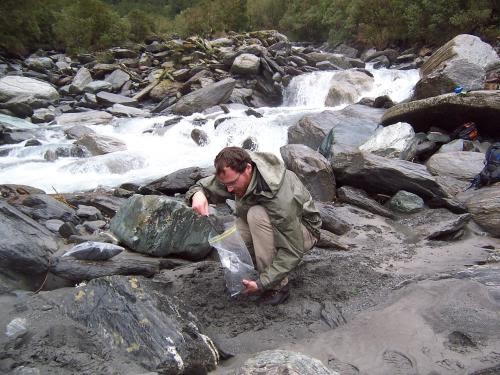
Geologic time is shorthand for slow-paced. But new measurements from steep mountaintops in New Zealand show that rock can transform into soil more than twice as fast as previously believed possible.The findings were published Jan. 16 in the early online edition of Science.
“Some previous work had argued that there were limits to soil production,” said first author Isaac Larsen, who did the work as part of his doctoral research in Earth sciences at the University of Washington. “But no one had made the measurements.”
The finding is more than just a new speed record. Rapidly eroding mountain ranges account for at least half of the total amount of the planet’s weathering and sediment production, although they occupy just a few percent of the Earth’s surface, researchers said.
So the record-breaking production at the mountaintops has implications for the entire carbon cycle by which the Earth’s crust pushes up to form mountains, crumbles, washes with rivers and rainwater to the sea, and eventually settles to the bottom to form new rock.
“This work takes the trend between soil production rates and chemical weathering rates and extends it to much higher values than had ever been previously observed,” said Larsen, now a postdoctoral researcher at the California Institute of Technology in Pasadena.
The study site in New Zealand’s Southern Alps is “an extremely rugged mountain range,” Larsen said, with rainfall of 10 meters (33 feet) per year and slopes of about 35 degrees.
To collect samples Larsen and co-author André Eger, then a graduate student at Lincoln University in New Zealand, were dropped from a helicopter onto remote mountaintops above the tree line. They would hike down to an appropriate test site and collect 20 pounds of dirt apiece, and then trek the samples back up to their base camp. The pair stayed at each of the mountaintop sites for about three days.
“I’ve worked in a lot of places,” Larsen said. “This was the most challenging fieldwork I’ve done.”
Researchers then brought soil samples back to the UW and measured the amount of Beryllium-10, an isotope that forms only at the Earth’s surface by exposure to cosmic rays. Those measurements showed soil production rates on the ridge tops ranging from 0.1 to 2.5 millimeters (1/10 of an inch) per year, and decrease exponentially with increasing soil thickness.
The peak rate is more than twice the proposed speed limit for soil production, in which geologists wondered if in places where soil is lost very quickly, the soil production just can’t keep up. In earlier work Larsen had noticed vegetation on very steep slopes and so he proposed this project to measure soil production rates at some of the steepest, wettest locations on the planet.
The new results show that soil production and weathering rates continue to increase as the landscape gets steeper and erodes faster, and suggest that other very steep locations such as the Himalayas and the mountains in Taiwan may also have very fast soil formation.
“A couple millimeters a year sounds pretty slow to anybody but a geologist,” said co-author David Montgomery, a UW professor of Earth and space sciences. “Isaac measured two millimeters of soil production a year, so it would take just a dozen years to make an inch of soil. That’s shockingly fast for a geologist, because the conventional wisdom is it takes centuries.”
The researchers believe plant roots may be responsible here. The mountain landscape was covered with low, dense vegetation. The roots of those plants reach into cracks in the rocks, helping break them apart and expose them to rainwater and chemical weathering.
“This opens up new questions about how soil production might happen in other locations, climates and environments,” Larsen said.
Note : The above story is based on materials provided by University of Washington










